
East Lancashire Railway is a 12.5-mile (20 km) heritage railway line in North West England which runs between Heywood, Greater Manchester and Rawtenstall in Lancashire. There are intermediate stations at Bury Bolton Street, Burrs Country Park, Summerseat and Ramsbottom, with the line crossing the border into Rossendale serving Irwell Vale and Rawtenstall. Before closure, the line terminated at Bacup.
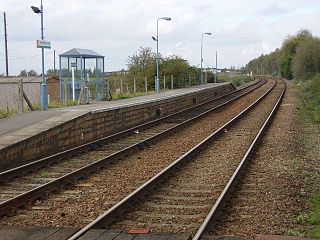
Haddiscoe railway station is on the Wherry Lines in Norfolk, England, named after the village of Haddiscoe, some 2 miles (3.2 km) distant, although the village of St Olaves on the other side of the River Waveney is closer. It is 16 miles 11 chains (26 km) down the line from Norwich on the route to Lowestoft and is situated between Reedham and Somerleyton. Its three-letter station code is HAD.

Medstead and Four Marks railway station is a railway station in the English county of Hampshire, serving the villages of Medstead and Four Marks. At 644 ft above sea level, it is currently (2016) the highest operational standard-gauge railway station in Southern England.

Threlkeld railway station was situated on the Cockermouth, Keswick and Penrith Railway between Penrith and Cockermouth in Cumbria, England. The station served the village of Threlkeld. The station opened to passenger traffic on 2 January 1865, and closed on 6 March 1972.

Rushall railway station was a station serving the villages of Blakenall Heath and Rushall in the Metropolitan Borough of Walsall, England. It was on the South Staffordshire Line between Walsall and Lichfield.

Summerseat is a village in the Metropolitan Borough of Bury, Greater Manchester, England, directly south of Ramsbottom.
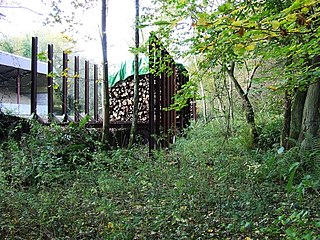
Withington railway station was on the Midland and South Western Junction Railway serving the village of Withington in Gloucestershire. The station opened to passengers on 1 August 1891 with the opening of the section of the line between Cirencester Watermoor and the junction at Andoversford with the Great Western Railway's Cheltenham Lansdown to Banbury line, which had opened in 1881.

Honing railway station was a station in Norfolk, England, serving the small village of Honing. It was on the Midland and Great Northern Joint Railway between Melton Constable and Great Yarmouth. It closed along with the rest of the line in 1959.

Weybourne railway station is a station in Weybourne, Norfolk on the preserved North Norfolk Railway. It was formerly part of the Midland and Great Northern Joint Railway route between Melton Constable and Cromer. Regarded as an iconic Edwardian masterpiece, the station is locally known as "Webbun". The station is open everyday the railway is operating trains, and holds various themed events throughout the year,
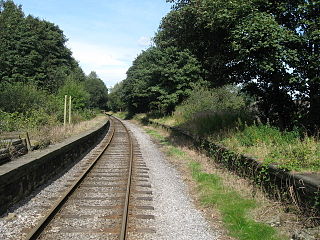
Stubbins railway station served the village of Stubbins, Rossendale, Lancashire, England. Opened by the East Lancashire Railway in 1847 on their line from Bury Bolton Street into Rossendale, it was situated next to the junction of the lines toward Accrington and to Rawtenstall and Bacup, but only had platforms on the latter route.
Scratby Halt was a railway station on the Midland and Great Northern Joint Railway which served the Norfolk village of Scratby, England.
Spratton railway station is a former railway station which served the village of Spratton in Northamptonshire, England.

Buckden railway station was a railway station in Buckden, Cambridgeshire. The station and its line closed in year 1959. The signal box is now preserved and in use as Tunbridge Wells West signal box on the Spa Valley Railway.
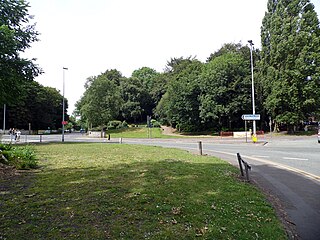
Monton Green railway station is a closed station in Eccles.
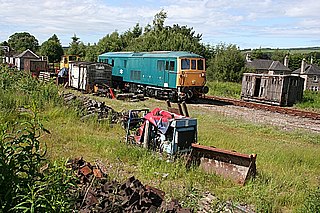
Dufftown railway station is a preserved railway station that serves the burgh of Dufftown, Moray, Scotland on the Keith and Dufftown Railway.
Rawlinson Bridge was the first railway station in the Borough of Chorley in Lancashire, England. The station was located in the village of Heath Charnock and was situated on the Bolton to Preston Railway. The station opened on 4 February 1841 by act of Parliament, the Bolton and Preston Railway Company had constructed a link with the Manchester line comprising nine and a half miles of railway to a station which was to be a temporary terminus as the railway continued to be built towards Chorley. Four years later on 22 December 1841 the line had reached Chorley and was superseded by more centralised stations at Chorley and Adlington.
Ryton railway station was a station in Ryton, Tyne and Wear, England. This large village is situated to the south of the River Tyne, at an elevation of some 60–90 metres, some 7 miles west of central Newcastle upon Tyne and within a half mile of the Newcastle-to-Carlisle railway, which roughly follows the course of the river along its south bank. With the opening of that railway, initially between Blaydon and Hexham, in 1835, a rail station was built to serve the village, and for many decades it was used especially by commuters to Newcastle.
Arkleby railway station was an early railway station on the Maryport and Carlisle Railway, in north-west England, close to the village of Arkleby in Cumbria, closing in 1852.
Roebuck railway station served the village of Bilsborrow, Lancashire, England, from 1840 to 1849 on the Lancaster and Preston Junction Railway.













